Saltwater Plants for Aquarium are still relatively new to the hobby. It is not always easy to create a balanced ecosystem to keep plants alive. There are many requirements: Substrate, filtration, nutrients, lighting, nitrates and oxygen. How do you maintain an environment for your marine reef aquarium plant?
Saltwater plants for aquarium will breathe life into your marine set-ups
Saltwater aquarium plants will light up your aquatic exposition with vibrant colors and trippy shapes. Aquarium plants keeps your fish happy in a healthy environment, even helping you to keep your aquariums clean.
Of course, you will want to ensure that you can choose the best ones for your tank, so we have rounded up the best-recommended suggestions for your fish tank. With an extensive list of saltwater aquarium plants, you can buy ectopic fish and plants from our collection of aquatic and horticultural resources and articles.

Choosing the right saltwater plants for aquarium
When choosing fish, it is relatively easy to determine if will be friendly with others. If plants are healthy, but there is fish or another occupant who eat them, dig up roots, or have no carbon dioxide, plants will not survive. Similarly, it would help if you considered the chemical balance inside the saltwater aquarium.
Moreover, temperatures are constant, and clarity is needed for photosynthesis. When the temperature is too high or too cold, everything suffers. If the ecology works appropriately, the plants and fish must work together to maintain the right balance in the aquarium.
Saltwater plants for your refugium
If you’re raising saltwater fish, this stocked reserve is natural to remove harmful nitrates from your aquarium. Marine plant systems may be a reasonable means of filtering your system. seaweeds help weeded out unwanted algae by keeping them away from the surface.
In addition, Saltwater plants can create ornamental crops, reduce Nitrites (NO3) and phosphates (PO4), and provides an inexpensive and attractive source of nutrient for fish.
Chaeto Macroalgae
Chaetomorpha is among the populous seaweeds croalgae with good reason. The colonies produce thick mats, which are highly helpful in the control of nutrients. Chaeto offers dense hiding places for copepods, fish, and other minor creatures.
Please be sure to screen new algae purchases carefully, as unauthorized hitchhikers may come into your ecosystem as snails or bristle worms. There are several types of species in the genus, but the most common, the Chaetomorephrea chaeto, is edible.

Red Gracilaria Algae
Red Gracilaria Algaeis a beautiful alga, and it brings a very dark red tint to your aquarium. It is suitable for cleaning water and for providing nutritional benefits for plants-eaten fish. Perfect for managers and angelfish, this growing tree is easy to care for with the appropriate lighting and moderate flow conditions.
Many hobbyists choose to grow that algae in a refugium and feed on the fish in little pinches occasionally. However, it can easily be placed in the main tank since its appearance is lovely!

Spaghetti Algae aka Chaeto
It absorbs Nitrates and releases loads of oxygen, so your marine life will love this addition to your tank. A lot of fish don’t attempt to eat this plant, but smaller fish often find more food in its pods. It’s hardy plants and won’t bother us when we have it in our saltwater aquarium.
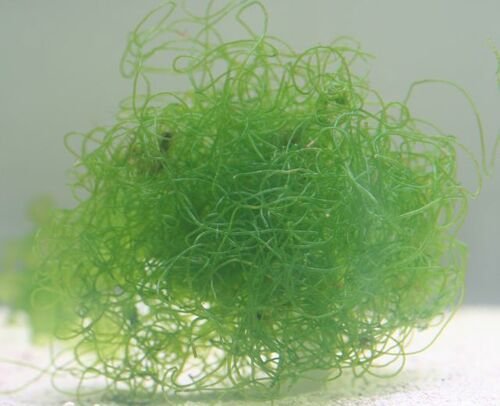
Mermaid’s fan
Mermaid’s fan is a tremendous decorative alga for saltwater aquariums. It has a vast, beautiful green leaf with an almost mermaid tail. The mermaid’s fan is easy to take care of once he settles down into the tank. This living plant requires illumination and supplement to survive. Make sure your aquarium has adequate amounts.
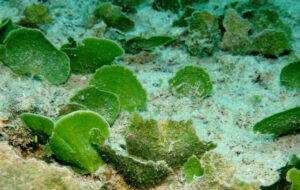
Green Finger Plant
This algae is both beautiful and hardy and is a favorite with saltwater aquarium hobbyists. Most fish don’t eat this plant, so you should be worried about being destroyed by hungry fish. A green finger alga makes an excellent filter, so your tank stays clean.

Halimeda
Species are discovered at high depth; therefore, their adaptability is high. Halimeda algae retain higher concentrations of ccalciferous alcium.
Their grow is a reliable indicator of a sufficient level of calciferous for corals to grow. They may be attached to the surface of a coral or alive rock. They are also a calcified type of macroalgae and use limestone (calcium carbonate) as a structure.
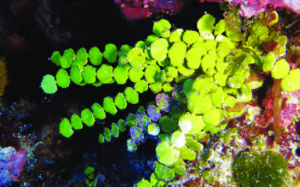
Sea Lettuce
There is a widely available macroalga type, and it is one of the hardiest species. Lettuce grows in an intertidal zone on ocean-wide shores. Growing on wave-swept rocks and gravel, the plant will be exposed ever to the harsh bright and warm air.
It also grows quickly enough to overcome snails, limpees, and other herbivorous plants. It is a beloved selection of algae for most people.
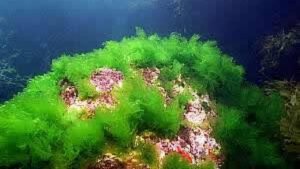
Blue Hypnea
Blue Hypnea is an important crown jewel of the macroalgae world. Hailing from Micronesia, the deep iridescent algae are intensely blue. It is a relatively slow-growing species that forms small mats that rarely grow more than 3 inches in height. It is usually saved as a decorative plant and thrives under the intense coral bright. The specie grows quickly.

Shaving Brush Plant
It is diverse macroalgae in terms of appearance. Others have spherical tops, while others are taller or resemble barbers’ brushes.
Each has a small stalk anchored in sand or other substrates. The height can vary and is between 4 and 12 inches. The size can reach 12 inches. For growth, the dissolved calcium content of 200 to 200ppm is ideal.
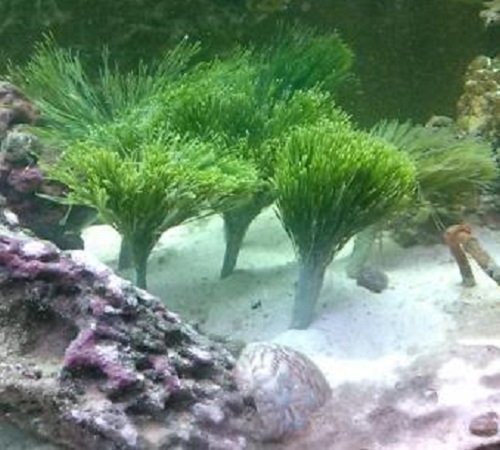
Red Mangrove Propagule (Rhizophora Mangle)
Mangrove is a beautiful addition if used. Grown in pairs, these tall plants can appear like bamboo forests. The leaves must remain above water so the roots can be easily anchored to dry rock or solid sand. The seeds are the best selection for propagation in your aquarium tanks.
Turtle Grass Shoots (Thalassia testudinum)
Turtle grass is seaweed and macroalgae that you can easily use as a mat for a tank. This can be used in groups to produce a natural fresh looking sandy bottom in your ocean tank life.
Many things need extra attention. Turtle grass requires minimal illumination and water circulation to look attractive and quality. It’s native site is Florida’s Gulf Coast, where it is seen in its natural habitat.

Water primrose
Water primrose grows in or underneath the water. It can display a distinct reddish-brown tint that will brighten your otherwise green aquarium.
This versatile plant is an excellent addition to your Aquarium but requires iron fertilizers best for development. You’ll want to maintain an ideal environment for your primroses to make sure you get the bright color of the leaves.

Dragon’s Tongue
Dragon’s Tongue tolerates medium luminosity environments. It is particularly variable in form, with anemones like increase form given much higher luminosity.
The plant also prefers mild current, so placing it near a drain leads to more significant growth. It will grow higher when it low light conditions than in a high light environment.

Tufted Joint Algae
Tufted Joint Algae is a small segmented green plant with small feathered branches at the of which the plant appears to be from prehistoric eras.
The plant oxygenates the water and balances nitrogen. It should be anchored to a reef and requires medium lighting for best results. It doesn’t do well within environments with heavy concentrations of nitrates and phosphates.

Highly Nutritious
All macroalgae are rich in iodine, ribose, and magnesium to provide the aquarium with calcium. Herbivorous fish such as tangs can often suffer nutritional deficiencies when forced to eat just food feed.
If yours is slow-growing, you could always supplement its diet with dried macroalgae preparations.
Plants Eliminate Unwanted Algae
Marine tanks have advantages in fighting off algae. Because larvae first feed on nitrate that the microalgae use for survival is eliminated. It can be said that microalgae starve and die because of nitrate deficiency and the moral of the story is simple.
You can use macroalgae for managing dangerous algae in a sea tank. Over time microalgae become starved and die from a nutrient deficit.
Conclusion: A great alternative to Coral (Saltwater Plants for Aquarium)
Almost all macroalgae species get by on very little light and require relatively low levels of water. The plants need a moderate amount of free-moving nutrients for growth to be healthy. Other species such as calciferous Halimeda have similar care requirements as coral. Corals require impeccable water condition, stability, and an intense light setup. Many macroalgae grow alongside them.
The right plants can help keep the water chemistry balanced and provides feed for plants-eating animals. The wrong plant may cause havoc in large tanks or be quickly eaten and destroyed. A little study can go a very long way, and it is usually easy to fix any situation.
